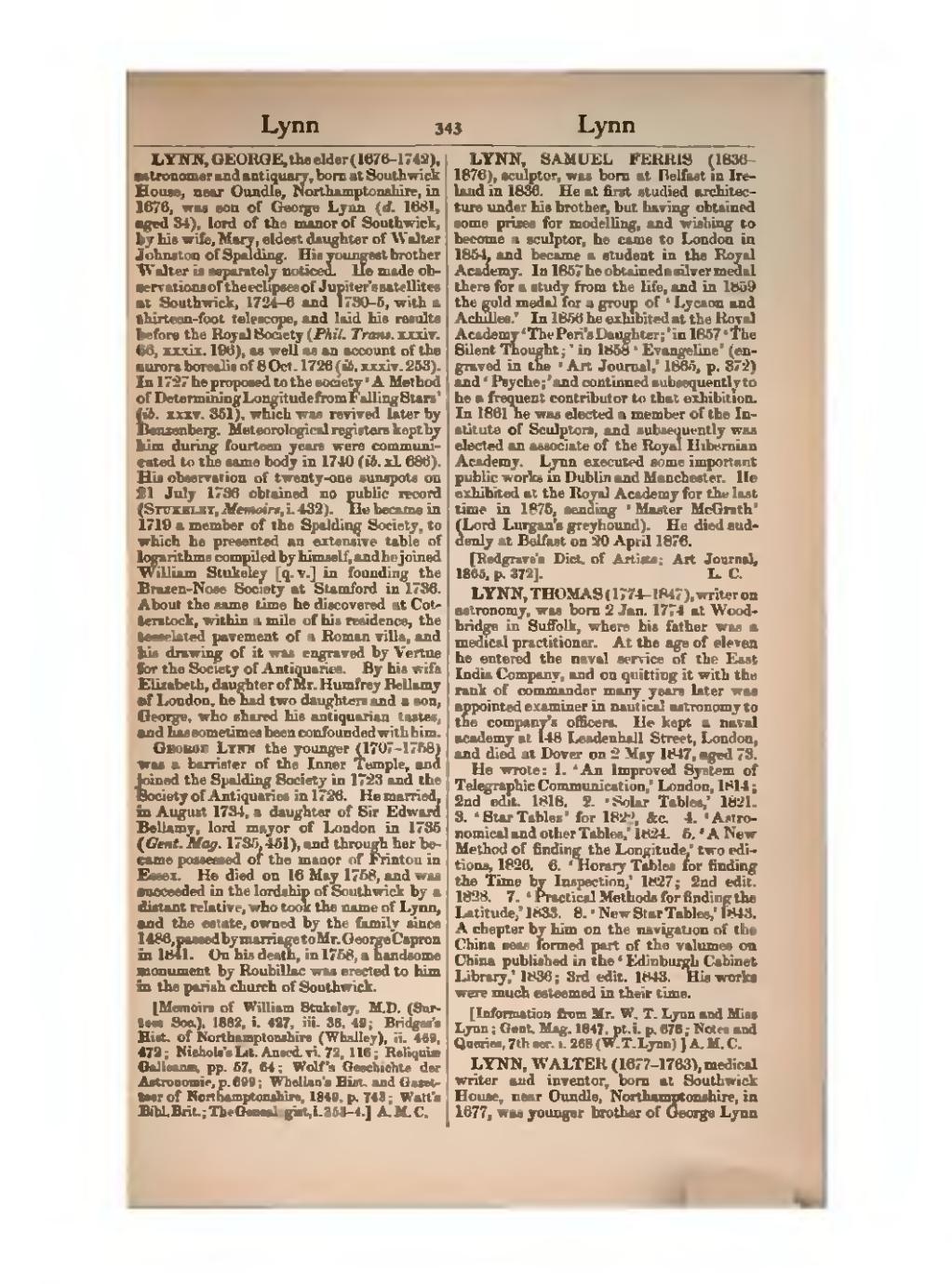LYNN, GEORGE, the elder (1676–1742), astronomer and antiquary, born at Southwick House, near Oundle, Northamptonshire, in 1676, was son of George Lynn (d. 1681, aged 34), lord of the manor of Southwick, by his wife, Mary, eldest daughter of Walter Johnston of Spalding. His youngest brother Walter is separately noticed. He made observations of the eclipses of Jupiter's satellites at Southwick, 1724–6 and 1730–5, with a thirteen-foot telescope, and laid his results before the Royal Society (Phil. Trans. xxxiv. 66, xxxix. 196), as well as an account of the aurora borealis of 8 Oct. 1726 (ib. xxxiv. 253). In 1727 he proposed to the society ‘A Method of Determining Longitude from Falling Stars’ (ib. xxxv. 351), which was revived later by Benzenberg. Meteorological registers kept by him during fourteen years were communicated to the same body in 1740 (ib. xl. 686). His observation of twenty-one sunspots on 21 July 1736 obtained no public record (Stukeley, Memoirs, i. 432). He became in 1719 a member of the Spalding Society, to which he presented an extensive table of logarithms compiled by himself, and he joined William Stukeley [q. v.] in founding the Brazen-Nose Society at Stamford in 1736. About the same time he discovered at Cotterstock, within a mile of his residence, the tesselated pavement of a Roman villa, and his drawing of it was engraved by Vertue for the Society of Antiquaries. By his wife Elizabeth, daughter of Mr. Humfrey Bellamy of London, he had two daughters and a son, George, who shared his antiquarian tastes, and has sometimes been confounded with him.
George Lynn the younger (1707–1758) was a barrister of the Inner Temple, and joined the Spalding Society in 1723 and the Society of Antiquaries in 1726. He married, in August 1734, a daughter of Sir Edward Bellamy, lord mayor of London in 1735 (Gent. Mag. 1735, 451), and through her became possessed of the manor of Frinton in Essex. He died on 16 May 1758, and was succeeded in the lordship of Southwick by a distant relative, who took the name of Lynn, and the estate, owned by the family since 1486, passed by marriage to Mr. George Capron in 1841. On his death, in 1758, a handsome monument by Roubiliac was erected to him in the parish church of Southwick.
[Memoirs of William Stukeley, M.D. (Surtees Soc.), 1882, i. 427, iii. 38, 49; Bridges's Hist. of Northamptonshire (Whalley), ii. 469, 472; Nichols's Lit. Anecd. vi. 72, 116; Reliquiæ Galleanæ, pp. 57, 64; Wolf's Geschichte der Astronomie, p. 699; Whellan's Hist. and Gazetteer of Northamptonshire, 1849, p. 743; Watt's Bibl. Brit.; The Genealogist, i. 353–4.]
LYNN, SAMUEL FERRIS (1836–1876), sculptor, was born at Belfast in Ireland in 1836. He at first studied architecture under his brother, but having obtained some prizes for modelling, and wishing to become a sculptor, he came to London in 1854, and became a student in the Royal Academy. In 1857 he obtained a silver medal there for a study from the life, and in 1859 the gold medal for a group of ‘Lycaon and Achilles.’ In 1856 he exhibited at the Royal Academy ‘The Peri's Daughter;’ in 1857 ‘The Silent Thought;’ in 1858 ‘Evangeline’ (engraved in the ‘Art Journal,’ 1865, p. 372) and ‘Psyche;’ and continued subsequently to be a frequent contributor to that exhibition. In 1861 he was elected a member of the Institute of Sculptors, and subsequently was elected an associate of the Royal Hibernian Academy. Lynn executed some important public works in Dublin and Manchester. He exhibited at the Royal Academy for the last time in 1875, sending ‘Master McGrath’ (Lord Lurgan's greyhound). He died suddenly at Belfast on 20 April 1876.
[Redgrave's Dict. of Artists; Art Journal, 1865, p. 372.]
LYNN, THOMAS (1774–1847), writer on astronomy, was born 2 Jan. 1774 at Woodbridge in Suffolk, where his father was a medical practitioner. At the age of eleven he entered the naval service of the East India Company, and on quitting it with the rank of commander many years later was appointed examiner in nautical astronomy to the company's officers. He kept a naval academy at 148 Leadenhall Street, London, and died at Dover on 2 May 1847, aged 73.
He wrote: 1. ‘An Improved System of Telegraphic Communication,’ London, 1814; 2nd edit. 1818. 2. ‘Solar Tables,’ 1821. 3. ‘Star Tables’ for 1822, &c. 4. ‘Astronomical and other Tables,’ 1824. 5. ‘A New Method of finding the Longitude,’ two editions, 1826. 6. ‘Horary Tables for finding the Time by Inspection,’ 1827; 2nd edit. 1828. 7. ‘Practical Methods for finding the Latitude,’ 1833. 8. ‘New Star Tables,’ 1843. A chapter by him on the navigation of the China seas formed part of the volumes on China published in the ‘Edinburgh Cabinet Library,’ 1836; 3rd edit. 1843. His works were much esteemed in their time.
[Information from Mr. W. T. Lynn and Miss Lynn; Gent. Mag. 1847, pt. i. p. 676; Notes and Queries, 7th ser. i. 268 (W. T. Lynn).]
LYNN, WALTER (1677–1763), medical writer and inventor, born at Southwick House, near Oundle, Northamptonshire, in 1677, was younger brother of George Lynn
